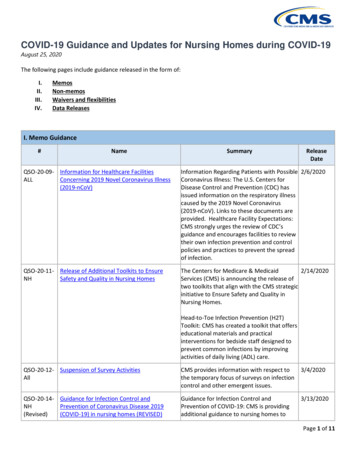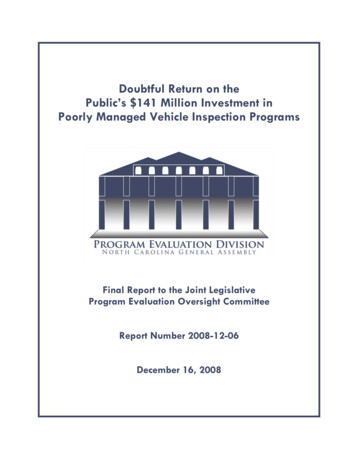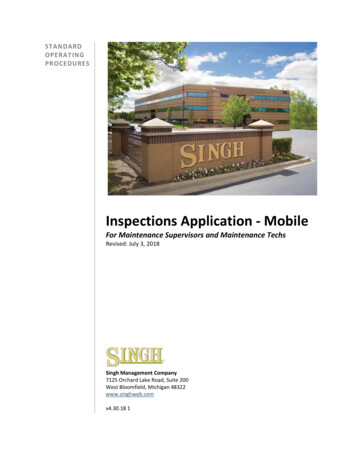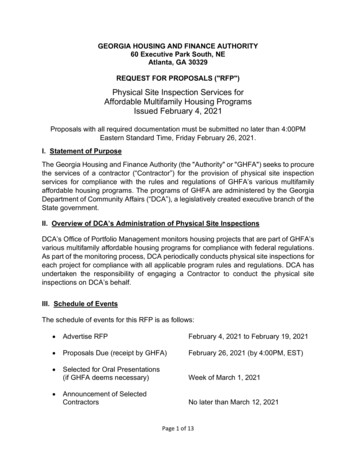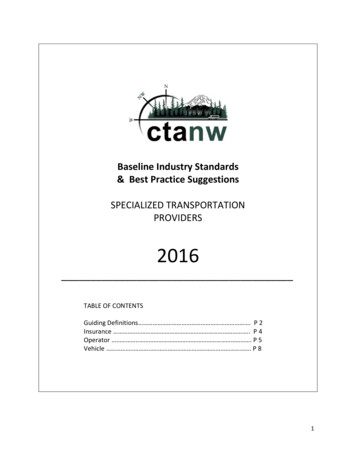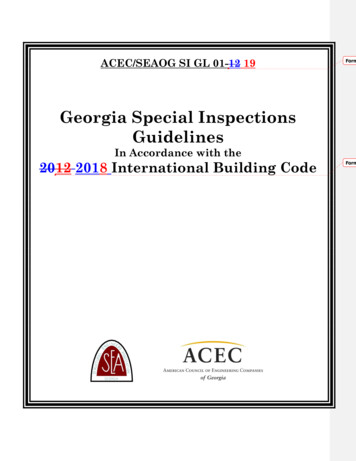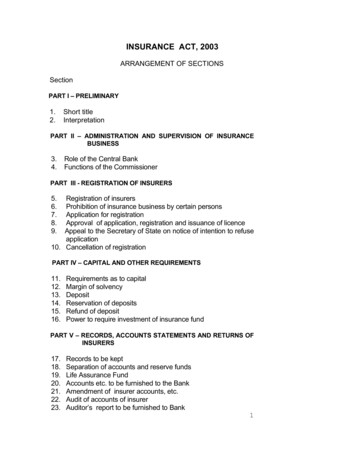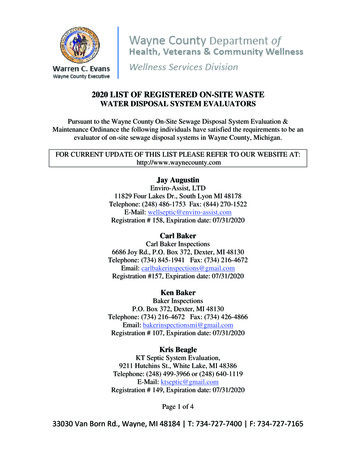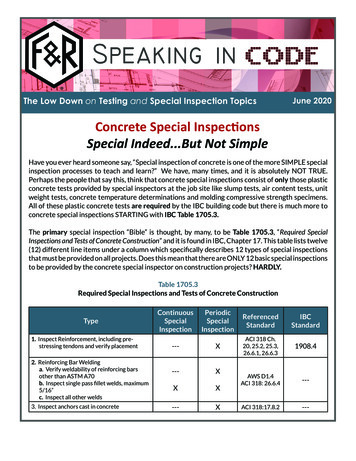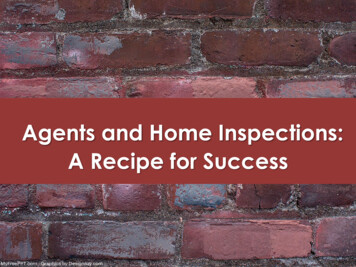
Transcription
Agents and Home Inspections:A Recipe for Success
James P. Allen, ACIPresidentSweet Home Inspections IncJames@SweetHomeInspections.comASHI Certified InspectorKS Dept Of Agri Pest CertificationKS Dept of Health and EnvironmentKS Real Estate Sales LicenseASHI National Director 2013-2016ASHI Foundation Director 2013-2016Great Plains ASHI Director 2017
Course Objectives Identify the importance of a home inspection Describe the home inspection process Define the most common types of inspections Describe common issues found in homeinspections Identify how to choose a home inspector Help you serve your clients better
Course Outline Why am I really here?What is a home inspection?5 critical areas of the home inspectionWhat occurs during a home inspection?Types of inspections 101 (introduction)Types of inspections 201 (deeper discussion)Your role in the home inspection processSome of the most common problemsChoosing a professional home inspector
Why am I really here? If you don’t know, you’re not alone This isn’t just about looking at homes anymore. The most crucial and misunderstood relationshipin residential real estate The decision to use a particular home inspector istoo important to leave to price or the flip of acoin. The decision of whether to get a home inspectionshould be out of the question!
What is a home inspection? A home inspection is anobjective, visualexamination of the physicalstructure and systems of ahouse. It’s like a medical checkup If a problem is detected, areferral is made to aspecialist.
The 5 Critical Areas of a HomeRoofElectricalPlumbingHVACFoundation
What Occurs During A Home Inspection? Pre-Inspection*Property, Site & ExteriorRoof & AtticStructure, Basement & CrawlspaceElectrical & PlumbingHeating & Air ConditioningKitchens & BathroomsLiving AreasHealth, Fire & SafetyPost-Inspection*
Pre-Inspection Meet the client Assess their concernsand desires Establish clearexpectations Explain the homeinspection
Property, Site & Exterior Foundation TypeDrainage, Grading and VegetationExterior SidingDecking/Patios and Flat workWindows, Doors and JointProtection Maintenance Tips
Roof & Attic Roof Covering Accessories (stacks,chimneys, skylights) Gutters andDownspouts Attic Structure Ventilation/Moisture Maintenance Tips
Structures, Basements & Crawlspaces Type of StructureCondition of StructureInsulation and VentilationFinished BasementsMaintenance Tips
Electrical & Plumbing Size and Condition of ElectricService Electrical Panel, Shut-off andWiring Water Main and Shut-off Distribution Piping Hot WaterSupply Plumbing Appliances andFixtures Maintenance Tips
Heating & Air Conditioning Identify the SystemCondition of the UnitUnheated AreasHumidifiers/AirExchangers: ERV & HRVs Maintenance Tips
Kitchens & Bathrooms Functionality of Sinks, Tubs, Showers, ToiletsGFCI ProtectionVentilation/Humidity LevelsFunctionality of Major AppliancesMaintenance Tips
Living Areas Condition of Walls, Floors, CeilingsReceptacles and LightingDoors and WindowsFireplace/Wood StoveMaintenance Tips
Health, Fire & Safety Health, Fire, and Safety HazardsVentilation/Combustion Air SupplySmoke Detectors/ CO DetectorsMaintenance Tips
Post-Inspection Present and Review theReport Questions and Answers Telephone Consultation(as required)
Re-Cap to this point When should you NOT get a home inspection? A home inspection is an objective,examination of the physical structure andsystems of a house. The 5 critical areas of every home are The 2 most important parts of the actualinspection are the
Types of Inspections 101Pre-listing inspections Give the seller the opportunity to correctdefects prior to listing, provide a moreaccurate disclosure, take nasty surprises outof the equation and speed up the closing.Buyers inspections Give yourselves and your buyers the toolsneeded to make an informed decision aboutthe condition of the home and reduceliabilities for all involved.
Types of Inspections 101New Construction Inspection:Even new houses have problems.With the new paradigm of teardown builders and largedevelopments, inspection of newconstruction is crucial.11th Month Warranty Inspections:Aka Builder’s Warranty Inspection.Your clients have bought thatnew home and the builder’swarranty is about to expire. Are theyready? Get a professional inspectionto get the most out of it.
Types of Inspections 101Phased Construction Inspection:Building your own custom home? Why nothave an expert on your side? A homeinspector can be your eyes and ears on-site.Renter’s Security Deposit Inspection:Have a certified home inspector documentthe condition of a rental property before itgets rented. Avoid the hassle of securitydeposit disputes with renters.
Types of Inspections 101Wood Destroying Insect (WDI) Inspection:Afraid your home may have termites?Make sure you know whether it does ordoes not with a state-certified pestinspection.Radon Gas Testing:What’s the leading cause of non-smokingrelated lung cancer in the U.S? You guessedit. Get it tested now or the next buyers might.
Types of Inspections 101Mold Inspection:There is mold all around us, butmold in large quantities can beharmful. Don’t hesitate callinga mold mitigation specialist.Sewer Scoping:Sometimes the things we can’tsee cause us the biggestheadaches. Sewer scoping is amust on older homes.
Types of Inspections 101Septic Systems:Rural properties are oftennot connected to citywaste systems. Regulationsvary from county to countyon septic inspectionsneeded during real estatetransactions.
Types of Inspections 201 The Ones You Need Now Know & WhyBuyer’sPre-listingReal Estate InvestorWood Destroying InsectRadonMold
Buyer’s Inspection Concisely conveys the property condition tothe client Transfers responsibility to the inspector. Limitsthe exposure and liability of yourself and youroffice:– Allows you to concentrate on taking care of theclient– Professional, fresh, & objective Can give you a serious edge in negotiating
Pre-Listing Inspection A home seller’s ultimate gesture of honesty Helps with full-disclosure and mayeliminate future legal claims Provides a professional, third-party, unbiased,non-alarmist opinion to potential buyers May help with:– pricing the home realistically (maybe higher!)– reducing potential for deal falling through at lastminute– reducing last-minute negotiations and over-inflatedbuyers' costs
Pre-Listing Inspection Cannot be used to waive the buyer’s inspectioncontingency but allows you to anticipate what will beidentified Permits a clean home inspection report to be used as amarketing tool Permits you to attach repair estimates or paid invoices tothe inspection report Gives sellers time to make repairs and shop for competitivebids Identifies:– issues of immediate concern such as safety hazards, termiteinfestations, and radon gas– repairs that if made will make your listings show better
Pre-Listing InspectionLastly Sell your listings up to 50% faster, which meansyou get paid sooner and your client is happier!
The New Construction InspectionBecause a house is new doesn’t mean it’s perfect. Builder defects are a common problem. An inspection before the walk-through canidentify repairs needed before your client takespossession. An inspection will provide a “punch list” for thefinal walk-through. Results in a happier buyer and can even result infewer service calls to the builder.
The 11th Month InspectionConducted on new construction homes before thebuilder’s 12-month warranty period expires Identifies all the existing defects so they get the mostout of their warranty Homeowners will likely overlook certain items they’vebecome used to or don’t realize are defects. Thisprovides a set of fresh, objective and trained eyes tohelp avoid future headaches. This appeals to price-sensitive clients since this isusually a reduced-price inspection (home is less than 1year old).
The WDI InspectionIt’s not a matter of if you get termites, it’s a matter of when. Home inspections and termite inspections go togetherlike peanut butter & jelly.– Termite inspections are required for FHA loans Nationwide, termites cause more than 2.5b worth ofstructural damage that is not covered by homeownersinsurance. Termite presence does not have to kill the deal, and canbe dealt with quickly and relatively inexpensively. The whole house should be treated, not just the area(s)where the termites were discovered.
The Radon InspectionThe leading cause of non-smoking related lungcancer in the U.S. Naturally-occurring radioactive gas that comesfrom the ground. Age of home doesn’t matter. Approx. 1/3 of homes in the Kansas City metrohave higher than recommended levels. Homes above 3.9 pCi/l should be fixed.
The Mold Inspection Everyone has a different sensitivity to each kind of mold;What is unhealthy for me may not bother you. Large quantities of mold aren’t good for anyone. Mold can be an indication of moisture issues in a home. It can’t always be seen (if it’s inside a wall). Regulations require professional clean-up for largeareas of mold. Mold testing can identify type and quantity present.
Your Role In The Inspection ProcessBefore During After
Your Role In The Inspection ProcessBefore the Inspection Contract, with the home inspection contingency, isaccepted by the seller. Supply referrals for at least three home inspectors. Client selects an inspector and sets a time. Arrange schedule so you can be at the inspection. Arrange for utilities to be turned on. Inform client of any defects already noted or disclosedand encourage them to be present during theinspection.
Your Role In The Inspection ProcessDuring the Inspection Encourage client to stay involved to ensureinspector communicates with them in theway you expect. Client should ask questions about anythingthat is not clearly explained. Be available for your client or the inspector toanswer questions about the contract anddisclosures.
Your Role In The Inspection ProcessAfter the Inspection Review the reports with your client. Discuss with your client what action they wantto be taken. Develop and submit a list of unacceptableconditions with the notice to the sellers.
Re-Cap to this point The 6 most common types of inspections are A home inspection places responsibility of theinspected systems on the shouldersand limits your Liability. It’s possible to sell a home % faster with apre-listing inspection. Radon is measured in .
What Do We Often Find ?
What Do We Often Find ?
What Do We Often Find ?
What Do We Often Find ?
What Do We Often Find ?
How Do I Choose A ProfessionalHome Inspector? Inspector should be a full-time professional andmember of a professional property inspectionorganization. Home inspectors are not required to be licensed inKansas or Missouri, but professional certifications canhelp you identify those with a base knowledge level. Inspector should carry Errors and Omissions orCommercial General Liability Insurance. Inspector should present information in an objectiveand professional manner. Ask other agents for references or interview theinspector.
Home inspections and termite inspections go together like peanut butter & jelly. -Termite inspections are required for FHA loans Nationwide, termites cause more than 2.5b worth of structural damage that is not covered by homeowners insurance. Termite presence does not have to kill the deal, and can
